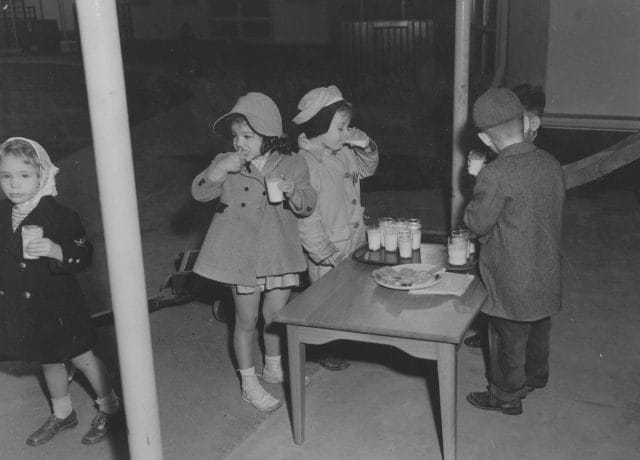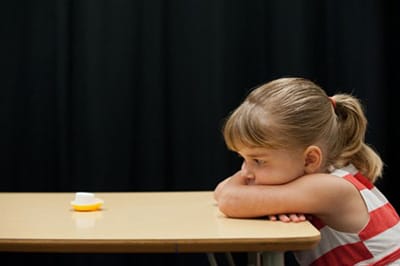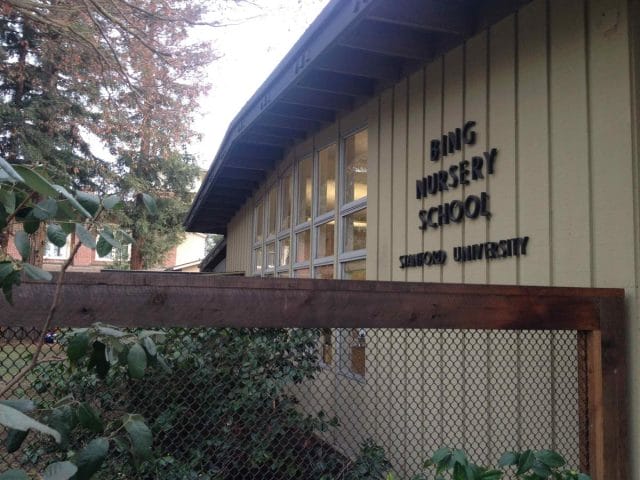
Researchers in developmental psychology face a formidable challenge: they need parents to sign consent forms allowing them to conduct experiments on their children.
The professors and students of Stanford University, however, don’t need to worry. At Bing Nursery School, 450 preschoolers readily participate in studies each year that investigate language acquisition, children’s ability to differentiate appearance from reality, and delayed gratification. The children’s parents sign blanket consent forms as a condition of admission just as readily due to Bing’s reputation as a great school.
Stanford’s psychology department subsidizes Bing Nursery School — an arrangement dating to the school’s predecessor, set up at the request of GI veterans with children attending Stanford after World War II. Parents still pay yearly tuitions of $6,000 to $14,000 for half day sessions of two to five days, which is comparable to prices at other selective, Bay Area preschools, although a scholarship fund makes admission need-blind.
With the help of a grant from the National Science Foundation and Stanford benefactors the Bing family, the new Bing Nursery School was built on 4 acres on the edge of Stanford campus in 1966. The school aimed to be a model nursery program as well as a place for researchers to study childhood development and Stanford education and psychology students to engage in hands-on education.
Visiting Bing Nursery, it’s easy to understand why parents not only feel comfortable with their children participating in psychological studies, but clamor to do so. Children roam through the classrooms out to ground’s gardens, “sand pools,” and patios. The school’s directors lecture in the Stanford psychology department and the teachers come well credentialed.
Although the parental competition to get their children into Bing Nursery School — as if it will be the difference between admission to Harvard or a non-Ivy one day — is a very modern day phenomenon, the school’s philosophy is not. The teachers practice a play-based curriculum advocated by the school’s founder, Dr. Edith Dowley, who wanted Bing Nursery to “give back to children some of the things modern living has taken away.” Teachers structure and shape hours of uninterrupted play that children fill with playing house, building towns out of sand, or making a book.
The research facilities at Bing have been the site of some of the most famous and impactful studies in developmental psychology. As Bing has facilitated understanding of child psychology, research in the field has continued to support Bing’s philosophy of the educational value of play for young children — even as more rigid educational structures appeal to anxious parents. The result is an institution as praised by academics for its cerebral examination of children’s psychology as it is cherished by parents and educators for its idyllic vision of childhood education. And even those who have never heard of it still have Bing to thank for a series of experiments tempting children with marshmallows to see how long they can resist.
A Different Species
Young children are aliens. At least that is this author’s belief. For those who don’t have or interact with kids regularly, it can be hard to remember the quirkiness of preschool aged children.
Take the example of John Flavell’s research on children’s “theory of mind.” A Stanford psychologist, Flavell’s research has shown how children struggle to understand the difference between appearance and reality. So, in one experiment performed at Bing, a researcher showed children a sponge painted to look like a rock.
In an interview, Flavell explains the setup:
We would then ask the child, “What is this?” The child would say, “It is a rock.” We would then proceed to let the child touch the object and see that it is a sponge and then follow with two more questions: (1) “When you look at this, does it look like a rock or look like a sponge?” and (2) “What is this thing really and truly, is it really a rock or really a sponge?”
Children of different ages answered distinctly. Older Bing students (ages 4 and 5) could correctly respond, “It looks like a rock but is really a sponge.” Most 3 year olds, however, responded either “rock” or “sponge” to both questions. Flavell concludes:
Three-year-olds can represent what they see in only one way. Three-year olds cannot differentiate between how something appears to be and how it really is.
Other research provides equally foreign findings. Within Flavell’s specialty, researchers have worked with preschoolers to document how younger children fail to realize that an expressionless person is in fact thinking as well as their failure to understand deception — according to Flavell, up to a certain age, children may lie about washing their hands because it’s the quickest path to snack time, but they don’t intend to mislead.
These strange characteristics of children are why institutions like Bing, which allow researchers to interact with very young children, are so important. Bing allows psychologists to study basic concepts like theory of mind (the understanding of different mental states in oneself and others) and language acquisition as they develop.
This is true in education research as well, where many measure the effects of different policies (smaller classrooms, different teaching styles, etc) by whether it increases or decreases test scores. So called “laboratory schools” like Bing offer more nuance, something especially important in preschool where test scores are in short supply and the skills being learned — the ability to express problems with words, a desire to learn — are so fundamental.
Setting Up Bing
Before Dr. Edith Dowley was named director of Bing Nursery School, before she taught the children of Stanford’s GIs, and before she was a PhD student at Stanford, she taught the children of America’s Rosie the Riveters at the Kaiser Shipyard during World War II.
During the war, the Kaiser Shipyards operated 24 hours a day. With the men drafted and women manning the factories, providing day care for those women’s children became a matter of national security, the key to the shipyard’s astonishing production of one “liberty ship” per day. Dowley supervised one day care center and later related that “The head of the Maritime Commission told the teachers that, without their help, it would have been impossible to keep the shipyards in production seven days a week.”
The Kaiser Child Service Centers at the Kaiser Shipyard. Credit: Kaiser Permanente
Rather than set up a daycare system of babysitters, the general manager of the shipyards, Edgar Kaiser, hired experts in the burgeoning field of childhood education to set up the Kaiser Child Service Centers. (And passed on the cost to the U.S. government in the form of more expensive Liberty Ships.) Teaching there, Dowley practiced and learned the ideas of educational reformers like Johann Heinrich Pestalozzi, who advocated the education of the whole person, recognizing individual student differences, and learning by doing during an age of rote learning; Fredrich Froebel, coiner of the term kindergarten (literally, “children’s garden”), who valued play as children’s natural state; and John Dewey, the American education reformer who expressed the following hands on, play-based vision of learning:
“When we look at early childhood classrooms today, we see children building language skills as they share snacks with classmates, learning important science concepts as they water and care for plants, and developing math skills as they cook up a special treat for lunch.”
It’s a quote that sounds right out of a Bing Nursery pamphlet as Edith Dowley applied their ideas to the creation of the school. She assigned each classroom a half acre of outdoor space and directed the construction of mounds, bridges, and sandy areas that would engage children. Today, heated floors allow the doors to remain constantly open at Bing, so that the classroom extends outside. Dowley instructed the architects to get on their knees to see the building from the children’s perspective — one reason Bing’s windows extend down to little kid level. Classrooms are filled with blocks, mini family rooms, and other materials meant to enrich the hours of unstructured play that feature prominently in children’s half day sessions at Bing.
The school’s Educational Philosophy is full of phrases like “children are good observers,” “children learn through play,” and “positive suggestions guide children.” Bing’s staff stress that play-based learning does not mean a free-for-all. Rather, it means teachers setting up an environment for learning and supporting kids’ own efforts.
Director Jennifer Winters gives the example of writing. Instead of forcing children to copy the teacher, Bing students naturally want to write when a teacher asks what they want to name a town they’ve built in the sand. And for preschoolers, the social and emotional aspects of play — learning to work with others and articulate and solve problems — are a big deal.
Learning about Bing Nursery School, this author expected that — as a laboratory school — its pedagogy had changed regularly as new teaching methods grew in popularity or fell out of favor among researchers. After all, the cutting edge of any field is rarely a stable place.
But the Bing School’s practices have remained constant since its founding. The philosophy described on its website and espoused fervently by its teachers draw clearly from Dewey to Dowley. In our conversations with Bing’s staff, the directors quoted Edith Dowley and former director Jeanne Lepper. “Edith understood children so well,” assistant director Beth Wise told us at one point. “She created a well run machine that hasn’t stopped working.”
Unlike laboratory schools like the University of Chicago’s nursery through high school programs, which focus on improving curriculum and teaching methods, research at Bing is not education focused.
Some do have an educational component. During our visit, we spoke with Sarah Gripshover, who is investigating whether nutrition education for young children can be improved by teaching them general principles rather than simply telling them what to eat and what to avoid.
Other Bing studies influence teachers’ practices indirectly. The work of Dr. Carol Dweck, formerly of Columbia, has shown how praising a person for good work, rather than the process used to complete it, can make children less confident and persistent when facing a difficult task in the future. Citing the influence of this study on staff, Wise told us that teachers will not tell a child who finishes a painting, “Good job. You’re so talented.” Instead, they praise the hard work, telling the child, “Did you see how hard you worked on that?”
But other research, like professor Ellen Markman’s study of the “naming explosion,” the period when children increase their vocabulary from “ten words to hundreds,” may take place with little impact on the school’s affairs other than the research coordinator fitting the experiments into Bing’s busy schedule.
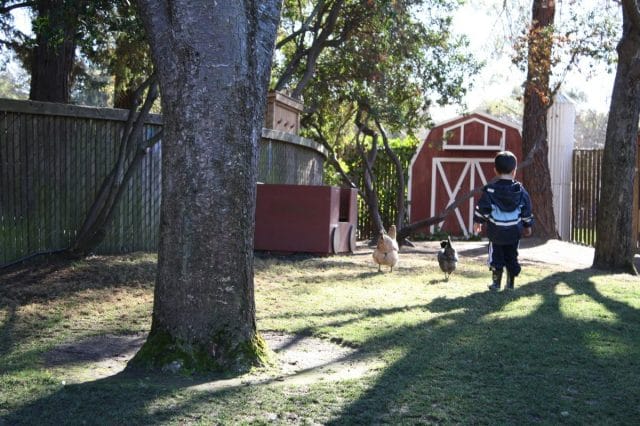
Filling the “Game Rooms”
After walking through Bing Nursery School — past children chasing fuzzy chickens over little hills, teachers reading stories with big smiles, and preschoolers showing off their crafts to engaged parents — the rooms where psych studies take place, known as “game rooms” for the children’s benefit, make for a stark contrast.
The bare, windowless rooms hold no distractions to mar the sanctity of Stanford’s research. Inside is a low table, two child-sized chairs, a video camera, and one-way glass for observation purposes.
Last year, 15 studies took place at Bing Nursery School. As they require multiple sessions, the game rooms are in use almost every day. Along with their professors and PhD students, around 30 or 40 student research assistants made regular trips to Bing. Each Bing preschooler participates in one or two studies per quarter, or perhaps one a month during busy periods. Children are always told some basics about the study and asked if they want to participate. But the preschoolers are usually happy to go, intrigued by the opportunity for a one on one interaction with the researcher.
According to research coordinator Chia-wa Yeh, the school manages to schedule time with the children for everyone who requests it. The researchers are mainly from the psychology department, although others come from all over the university. But Bing entertains no requests from researchers at other universities. Time at the Bing School is simply too valuable to share.
When a National Science Foundation grant helped found Bing, additional grants were meant for an additional 12 laboratory schools. But the money never materialized. So researchers without access to Bing, or one of its very few peers like Michigan’s Child Development Laboratory, face a logistics nightmare in working with young kids.
Psychologists approaching public schools require approval from multiple administrators at the school and district level. They often come as beggars, with little to offer the schools for their help. And even when the administration does approve, getting enough parents on board is difficult. “Even with very engaged, high socioeconomic status parents,” PhD candidate Sarah Gripshover told us, “you rarely get back more than 20% of the consent forms.”
Another tack researchers may take is to recruit study participants at a museum. The museum provides a room for the study, while the researchers make the hard sell to parents. The advantage is that museums have a wide age range of kids; the downside is that studies involving follow ups are impossible and researchers never know if enough participants will be available. Chia-wa Yeh cited the experience of one researcher at a museum who was unable to find a large group of 4 year olds she needed for a her study. Once at Bing, preschoolers of the right age were happy to participate.
The impact on researchers’ work is dramatic, often the difference between an experiment being feasible or not. As one graduate student reported, “If I didn’t have Bing as resource, it would take me 3-4 times as long, if not longer, to collect data for my studies.”
Bing’s resources helped immortalize what may be the most famous experiment to come out of Stanford, if not all of developmental psychology: the Stanford marshmallow experiments on delayed gratification.
As Priceonomics has covered previously, researchers under the direction of Dr. Walter Mischel brought children into a room one by one and tempted them with a five year old’s equivalent of Odysseus’s sirens: a marshmallow. The researchers told the children that they could have the marshmallow now. But if they waited 15 minutes without eating the marshmallow until the adult returned, they would earn a second.
This was not easy for the preschoolers. They fidgeted, covered their eyes to avoid seeing the treat, and, in several cases, simply ate the marshmallow immediately. One third of the kids persevered and earned themselves a second marshmallow.
A reenactment of the marshmallow experiment at the University of Rochester
The study intended to look at the development of delayed gratification, and it did find that older students could better resist the treat. But by observing children using strategies like facing away from the marshmallow, Mischel’s team also countered Freudian ideas of instinctual personality by showing how strategic thinking could overcome desire.
The story of Mischel’s marshmallows could have ended there in 1970. But by working with Bing students, he could more easily follow up with the study subjects. Over the following decades, he published a number of papers based on the same students, linking their ability to resist temptation in preschool to markers of success like SAT scores, body mass index, and parents’ or peers’ rating of their ability to focus. In one paper, he and a co-author wrote:
The qualities that underlie effective self-imposed delay in preschool may be crucial ingredients of an expanded construct of ‘intelligent social behavior’ that encompasses social as well as intellectual knowledge, coping, and problem-solving competencies.
The findings are some of the most celebrated in psychology, if contested: a competing 2012 study from the University of Rochester suggests that the ability of youngsters to pass the marshmallow test may be the result of strategic thinking about the researchers’ reliability more than a reflection of personal self-control. But the striking finding was the link between individuals’ performance in an experiment as preschoolers with life outcomes decades later. Had Dr. Mischel recruited participants at a museum who then scattered, or at a public school where the students were hard to track down, the follow up studies may have never been possible. Mischel calls the participants, “A very special group in the history of social science.”
Other psychologists took advantage of working with children at Bing to publish papers now considered formative in the field.
Dr. Mark Lepper investigated the relationship between motivation and rewards by inviting Bing students interested in drawing to use paper and crayons in a game room. One group received a surprise reward after, another group received a promised reward, and a third received no reward at all. The researchers then watched to see how long the children would continue drawing once they left the game room. Noting that preschoolers promised a reward drew for significantly less time, Lepper warned against the danger of extrinsic motivators. He posited that this explains why young children have boundless curiosity to learn, but seem to suffer from “motivation gaps” once in a structured school environment.
A well known 1960’s experiment by Albert Bandura looked at how children model aggressive behavior after adult examples. In the study, one group of Bing preschoolers watched an adult hit a “bobo doll,” a toy painted to look like a clown, with a toy mallet. Bandura found that the children who watched the adult would later hit the doll with a mallet after a frustrating experience much more frequently than the control group.
The researchers used the study, now known as the “bobo doll experiment,” and more complicated follow up studies, as support for models of learning focused on how children learn through observation and imitation. More widely, it became fodder in a debate over violence in the media, used to counter the now foreign idea that violent television might play a positive role in draining viewers of violent feelings.
Enough studies that took place at Bing have achieved renown for it to be commonplace, with Bing staff needing time to rattle off a tally of studies that they feel have been formative in their field. Bing Nursery School is a key component in keeping Stanford’s psychology department, as its website boasts, “number one in the country for the past 50 years.” As one student gushed, “When you take a social psychology class, it’s basically the history of Stanford psychology.” The unfair advantage for developmental psychologists of having Bing as a resource is one reason why.
Child’s Play
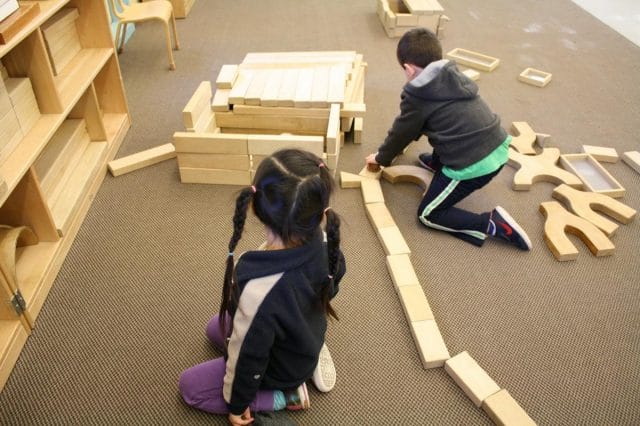
In 2010, the school’s portfolio expanded with the creation of the Bing Institute, an effort to promote Bing’s play-based education philosophy and share best teaching practices with childhood educators and parents. It’s an extension of the staff’s natural tendency to share their passion for teaching, but it’s also a response to a perceived threat.
Jennifer Winters, director of Bing Nursery School, referenced “push down” a number of times in our conversations. The term describes the effort to push the more formalized learning practices of elementary school down onto kindergarten and even preschool — the result of parents and schools anxious to see children perform, a focus on the direct and measurable exemplified by the testing standards of the No Child Left Behind Act. Winters referenced schools that cater to parents’ worries, foregoing play entirely in place of a strictly academic program.
From an outsider perspective, it’s a bit funny to read workshop descriptions about the educational properties of block toys. But for the Bing staff, it’s serious business. The difference between a child learning about fractions, symmetry, and balance from blocks, rather than, say, spending time imitating a teacher writing letters, is huge in their opinion. It’s the difference between a child who pursues learning as his or her own discovery, learns at his or her own pace, and loves school, and a child who learns only when told to by a teacher, fails to learn important social and emotional skills, and sees school as a chore.
The push to get children formally learning can seem a recent concern — born out of fear of a declining American education system and a rise in the stakes to win the education battle. But it’s existed as long as Bing Nursery School. In 1949, a young Edith Dowley wrote that everyone seems to be asking “What’s wrong with education in America today?” and she worried that:
Elementary schools are putting pressure on children because the high schools put pressure on them, and the colleges and universities in turn are browbeating the high schools until they think more in terms of “requirements” than about boys and girls.
The response today to those worries about “what’s wrong with education in America today?” is, most recently, interest in a government push for universal Pre-K education. New York City mayor Bill de Blasio made it a major part of his campaign platform, New York governor Andrew Cuomo has proposed the idea, and President Obama reiterated his preschool expansion push in his recent State of the Union address.
“I think universal Pre-K would be great. So many kids don’t have the opportunity,” Winters told us in reference to the idea. She also believes institutionalizing preschool would expand the focus on play-based curriculums.
It’s not that the idea of preschoolers spending lots of time playing is controversial — neither among parents who tell their kids to “go play” nor educators who learn its value. “The research on play is clear,” Winters told us. Staff at Bing can talk about foundational supporters of the importance of play through modern proponents without much in the way of dissent, while also throwing out research on the neuroscience of how play impacts neural connections for parents not swayed by turn of the century intellectuals. But that push down effect “is worrisome.” And the higher standards of a nationalized Pre-K, in Winters’s opinion, would mean more educated teachers who value play and know how to get it right.
Many politicians proposing expanded pre-kindergarten programs have not said how they will pay for it, so no one should hold their breath. Funding may fall short, just as it did when the National Science Foundation intended to create 12 schools like Bing.
Parents, researchers, and teachers alike express pride in the remarkableness of Bing Nursery school. “A national treasure,” in the words of one noted psychologist. But you also get the sense they’d be happy to see the rise of more peers, and for Bing to become a little less unique.
This post was written by Alex Mayyasi. Follow him on Twitter here or Google Plus. To get occasional notifications when we write blog posts, sign up for our email list.




